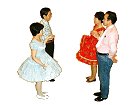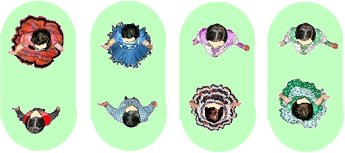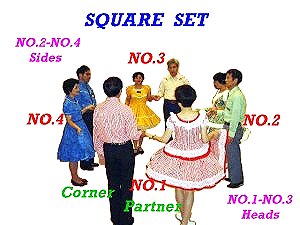| This Animated Square Dance Text was created by Mr. Hiroshi Yaoko,is member of Japan Square Dance Association Home Page Steering Committee, and member of Tokyo Square Dance Club. He presented this text to Japan Square Dance Association. Copyright (C) 2000 Japan Square Dance Association. All Rights Reserved. |
SQUARE DANCE TEXT
CALLERLAB BASIC & MAINSTREAM DEFINITIONS
Descriptions are quoted
from [ DoSaDo.com ] in U.S.ACALLERLAB BASIC & MAINSTREAM DEFINITIONS
Last Up Date:Octorber 1 2006
PREFACE
OBJECTIVE: The objective of the Mainstream call definitions is to provide clear, concise, simple explanations of the terms and calls used in the Mainstream Program.
(1) STARTING FORMATIONS Starting formations are listed for each of the defined calls. The smallest basic formation has been listed. Multiples of this formation may be possible. For example, the minimum number of dancers required to dosado is two. It is possible, however, to have four dancers in a line facing four dancers in an opposite line ready for a dosado. In this case, there are four multiples of the basic formation.

(2) FACING DANCERS Facing dancers, unless otherwise specified, may be any combination of men and women.
(3) COUPLES Couples, unless otherwise specified, may be any combination of men and women.
(4) PASSING RULE Whenever two dancers are walking toward each other and are about to collide, they pass right shoulders and continue.
(5)SAME POSITION RULE Whenever two dancers are walking toward each other and are required to occupy the same position, they join right hands in a mini wave sharing that position.
(6) FACING COUPLES RULE Some calls, which normally start from ocean waves, can also be done when dancers are in facing couples (e.g. Swing Thru, Spin the Top, etc.). In this case, the dancers first step into a momentary right hand ocean wave and complete the call unless the caller specifically directs a left hand call (e.g. left swing thru, etc.) in which case the dancers step into a momentary left hand ocean wave and complete the call. Exceptions to this rule are listed in the body of the definitions.
(7) OCEAN WAVE RULE Some calls which normally start from facing couples can be done when dancers are in ocean waves (e.g. Right and Left Thru, Box the Gnat, Square Thru, Slide Thru, Pass to the Center, etc.). In this case, the dancers have already stepped forward toward the facing dancer and are ready to complete the remaining action of the directed call. For the sake of dancer comprehension and teaching purposes, it may be necessary to initially have the dancers back up into facing couples, then step back into the wave and complete the call.
This rule also applies when calls which normally start from two facing dancers (e.g., Turn Thru) are called from a mini wave.
(8) REGIONAL STYLING DIFFERENCES CALLERLAB recognizes that regional differences in styling exist.
DEFINITION OF STYLING TERMS
Arms in Natural Dance Position: Arms should be held slightly bent in comfortable position in anticipation of the next movement.
Dance Step: Should be a smooth, effortless gliding step in which the ball of the foot touches and slides across the surface of the floor before the heel is gently dropped to floor. The length of stride should be fairly short with the movement coming mostly from knees down. Dance step must be coordinated with the beat of the music. In general terms, short gliding steps which utilize both ball and heel of the foot make a comfortable dance step.
DANCING HAND POSITIONS Couple Handhold: Inside hands joined. Men should always hold palms up, ladies palms down. In the event of a same sex couple, the left-hand dancer turns palm up, right-hand dancer turns palm down. Arms should be bent with hands held slightly higher than the elbow. Forearms are adjacent and can be held close together in locked-in position for wheel around type movement.
Forearm: The arms are held past the wrist but not past the elbow joint. Each dancer places the hand on the inside of the arm of the person with whom he is to work. The fingers and thumb are held in close. The center of the turn will be at the joined arms, so, while turning, each dancer is moving equally around the other.
Handshake Hold: Use a comfortable handshake with hands reached and touched at about average waist height. Thumb should overlap the back of the opposite dancer's hand. It is important in right and left grand to release hands when passing. Do NOT stretch or lean over to reach the next hand.
Loose Handhold: Hands revolve around each other maintaining contact and a certain degree of security or stabilization. Slight pressure is all that is required.
Hands Up: Hands are joined in crossed palm position; i.e. opposing dancers place palms together with finger pointing up, then tilt hand out slightly which will result in a crossed palm position. Thumbs are gently closed on the back of the opposing dancer's hand. As the turning action starts, wrists are straightened.Box Star/Packsaddle: Four men with palms down take the wrist of the man ahead and link up to form a box.
Palm Star: Place all hands together with fingers pointing up and thumbs closed gently over the back of the adjacent dancer's hand to provide a degree of stabilization. Arms should be bent slightly so that the height of the handgrip will be at an average eye level.
Posture: Dancers should stand erect and tall, shoulders back. Often tall people have a tendency to stoop, but should not.
Pull By:The action brings two people toward each other. Hands should be dropped before bodies cross a common plane.
Skirt Work: Ladies hold skirt in free hand about waist high using very slight rhythmical flourish to move skirt in front and back, right hand moving with left foot, left hand moving with right foot.
Promenade Ending Twirl: Man raises his right hand holding the lady's right hand loosely as she twirls clockwise underneath, ending in a squared up couples position.
STYLING FOR MAINSTREAM SQUARE DANCE CALLS
BOW (HONORS) To Your Partner:
Men: Turn slightly to face your partner making eye contact. Place left hand behind back or at left hip, palm out. Place right foot in front of left foot. The right foot should be pointed toward the lady with the toe touching the floor. man's right hand holds lady's left hand. Both legs are straight, with weight on the back foot.
Ladies: Turn slightly to face your partner making eye contact. Left foot should be pointed forward with toe touching floor, right foot in back. Right hand holds skirt toward center of square, right arm bent at elbow. Place left hand in partner's right hand. Both legs are straight with weight on back foot. [An acceptable traditional variation of styling is that the men bow slightly from the waist as the ladies acknowledge with a curtsy.]
To Your Corner:
Men: Right hand holding partner's left hand, turn slightly to face corner, making eye contact. Place left hand behind back or at left hip, palm out. Place left foot in front of right foot. The left foot should be pointed toward corner with toe touching floor. Both legs are straight with weight on the back foot.
Ladies: Left hand in partner's right hand, turn slightly to face corner making eye contact. Place right foot in front of left foot with the right foot pointed toward corner and the toe touching floor. Both legs are straight with weight on back foot. An acceptable traditional variation of styling is that the men bow slightly from the waist as the ladies acknowledge with a curtsy.
SQUARE DANCE FORMATION
CLICK HERE TITLE TO SQUARE DANCE FORMATION
FORMATION
| BASIC PROGRAM | ||
|---|---|---|
| LIST NO.1(BASIC) | LIST NO.2(BASIC) | LIST NO.3(BASIC) | 1. Dancer Naming a. Partner/Corner b. Heads/Sides c. Couple#1,#2,#3,#4 d. Boys/Girls e. Centers/Ends 2. Circle Left/Circle Right 3. Fowerd & Back 4. Do Sa Do/ Dosado to a Wave 5. Swing 6. Promenade/ Single File Promenade a. Couples(Full,1/2,3/4) b. Single File Promenade c. Star Promenade |
7. Allemande Left 8. Arm Turns a. Left Arm Turn b. Right Arm Turn 9. Right and Left Grand Family a. Right & Left Grand b. Weave the Ring c. Wrong Way Grand 10. Left-Hand Star/ Right-Hand Star 11. Pass Thru |
12. Split Two 13. Half Sashay Family a. Half Sashay b. Rollaway c. Ladies In, Men Sashay 14. Turn Back Family a. U-Turn Back b. Back Truck 15. Separete Around 1 or 2 a. to a Line b. and come into the middle 16. Courtesy Turn 17. Ladies Chain Family a. Two Ladies Chain(Reg. and 3/4) b. Four Ladies Chain(Reg. and 3/4) c. Chain Down the Line |
| LIST NO.4(BASIC) | LIST NO.5(BASIC) | LIST NO.6(BASIC) |
| 18. Do Pa So 19. Lead Right 20. Right And Left Thru 21. Grand Square 22. Star Thru 23. Circle to a Line |
24. Bend the Line 25. All Around The Corner 26. See Saw 27. Square Thru(1,2,3,4)/ Left Square thru (1,2,3,4) 28. California Twirl 29. Dive Thru |
30. Wheel Around 31. Thar Family a. Allemand Thar b. Allemande Left to an Allemand Thar c. Wrong Way Thar 32. Shoot the Star/ Shoot the Star Full Around 33. Slip the Clutch 34. Box the Gnat 35. Ocean Wave Family a. Step To A Wave b. Balance |
| LIST NO.7(BASIC) | LIST NO.8(BASIC) | LIST NO.9(BASIC) |
| 36. Alamo Ring Formation a. Allemand Left in the Alamo Style b. Ballance 37. Pass The Ocean 38. Extend (from 1/4 tag only) 39. Swing Thru/ Left Swing Thru 40. Run/Cross Run 41. Trade Family a. (named dancers)Trade b. Couples Trade c. Partner Trade |
42. Wheel And Deal 43. Double Pass Thru 44. First Couples Go Left/Right Next Couples Go Left/Right 45. Zoom 46. Fluteter Wheel/ Revers Flutter Wheel 47. Sweep a Quarter |
48. Veer Left/Veer Right 49. Trade By 50. Touch 1/4 51. Circulate Famly a. (named dancer)Circulate b. All 8 Circulate c. Couple Circulate d. Single File Circulate e. Splite/Box Circulate 52. Ferris Wheel |
| MAINSTREAM PROGRAM | ||
| LIST NO.10(MAINSTREAM) | LIST NO.11(MAINSTREAM) | LIST NO.12(MAINSTREAM) |
| 53. Cloverleaf 54. Turn Thru 55. Eight Chain Thru Eight Chain 1,2,3,etc 56. Pass to the Center 57. Spin the Top |
58. Centers In 59. Cast Off Three Quarters 60. Walk & Dodge 61. Slide Thru 62. Fold/Cross Fold |
63. Dixie Style to an Ocean Wave 64. Spin Chain Thru 65. Tag the Line (In/Out/Left/Right) 66. Half Tag 67. Scoot Back 68. Single Hinge/Couples Hinge 69. Recycle(from a wave only) |
| PLUS PROGRAM | ||
Back

